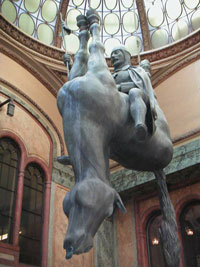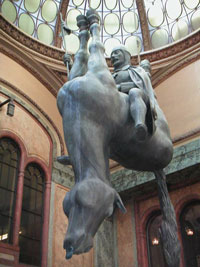
The Contagious Middle Ages Comes to Berkeley

During a stay at the Collegium Budapest nearly a year ago, friends told me that I had to see an exhibition at the Open Society Archives’ gallery in its beautifully restored building on Arany utca. The “Contagious Middle Ages” was not about plague, pox, and Dark Age hygiene. The contagion was now: infectious in the benign sense of enthusiasm for things medieval sweeping over East Central Europe since 1989, but virulent too in outbreaks of national, ethnic, and religious belligerence that Europe was supposed to have outgrown.
From north to south, from Estonia to Bulgaria, the epidemic of medieval allusions was poignant, zany, pompous, menacing, or all of those together. It ranged from innocent nostalgia and a surge of relief in the wake of Communism to nationalist demagogues, revanchists, and skinheads, with “medieval” rock music and creative anachronists in between. Scholarly medievalists have looked on with mingled surprise and alarm. The organizers of the Budapest exhibit chose as an icon for the appropriation of the past by the present the Czech artist David Cerny’s 1999 mock monument of Prince (and Saint) Wenceslas riding into the future on a topsy-turvy dead horse.
Real and imagined historical pedigrees have been notoriously contentious in East Central Europe, starting with the name itself. “East” insinuates “oriental” otherness, “Central” a Europe of empires with a suspect Germanic tinge. Either way, the region is a tilting ground for issues of historical identity and legitimacy. This is not to say that cultural differences are primordial there, always ready to sprout from the ashes of the latest attempt to suppress them. It is not news by now (if it ever really was) that national revivals in the region have entailed more than a fair share of wishful thinking and, at their brutal extreme, “ethnic cleansing,” the Orwellian term that came into international usage from the region. Professors and poets had told the folk they were folkish before they knew it. Even the Soviets and their satellites contributed with their official codification of nationalities and ethnic identities; falsifying history became a new tradition. But brittle nationalisms also remind us that nations and traditions get made or made up in the exuberant experiments and multimedia happenings documented at the Open Society Archives.
It is not so surprising that a medieval imaginary would come into view when iron curtains were lifted. Ever since the Renaissance, the idea of Middle Ages has been a whipping post for a long line of modernizers with their brave new worlds; when the Communist system collapsed, as a grim caricature of failed modernity, the Middle Ages took on a familiar role as alter ego and lost horizon. The golden ages and glory days in the region were medieval before their modern comeuppance in fragmentation and foreign conquest. Since the 19th century, national revivals were in large part medieval revivals (and inventions) that conveniently embraced the political spectrum from Left (the “progressive” Middle Ages of cities, constitutions, universities, etc.) or Right (the Age of Faith).
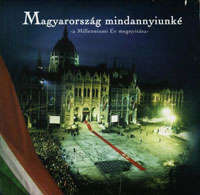
In a conference leading up to the Budapest exhibit, a prominent American medievalist observed that the Middle Ages were definitely back — and that this was not necessarily a good thing. By then, however, it was too late to have much confidence that the wet blankets of scholarship could dampen the enthusiasm. Since the early 1980s, scholars calling for a self-conscious (and often self-important) New Medievalism had re-examined the ideological agendas, contexts, and complicities of medieval studies, not just coincidentally but in its constitution as an academic field. Together with this came the dismantling of conventional narratives—medieval unity, harmony, hierarchy, the “medieval synthesis.” As the Middle Ages were, so to say, “re-medievalized,” the darkness of the Dark Ages that haunted the Romantic imagination returned; telltale bodies, rituals, relics, magic, persecution became hot topics. A pop New Medievalism paralleled the academic one. In a postmodern jumble chronicled by Umberto Eco in his Travels in Hyperreality (Eng. ed., 1986), Monty Python and Indiana Jones could discover Camelot, Star Wars recycle Charlemagne, knights become cowboys or sports stars, theme parks look like architectural restorations, Abu Ghraib parody museums of medieval torture. Not for the first time, demotic history left the academic kind in the dust.
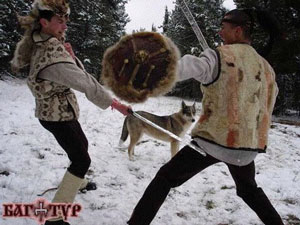
The OSA exhibit tried to catch up. It assembled a vast array of texts, images, and sounds from the lush undergrowth of “regime change” in the “New Europe,” as our politicians and pundits like to call a region that is actually obsessed by the past. To invert John Reed’s unfortunate quip about the Bolshevik revolution, we have seen the future, and it may be the past. For students of history, the exhibit raises serious questions about how to respond to the willful appropriation of history without knee-jerk assertions of authority or stowing away on a ship of fools. For all of us it is a case study in the frantic global quest for historical vindication that confronts us in so many forms and with such insistent urgency at the beginning of the new millennium.
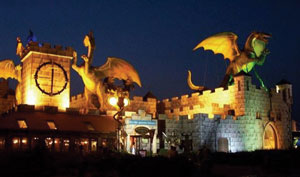
Hundreds of items were on display in Budapest in three or four times more space than the Townsend Center could offer. But I thought a sample could and should be brought to Berkeley, in particular to the Townsend celebrating its 20th anniversary as an interdisciplinary crossroads and forum for research, teaching, and public outreach. So much the better that the exhibit would fit in with the Center’s current series, the Forum on the Humanities and the Public World. The Hungarian organizers were enthusiastic; soundings on campus produced a host of willing co-sponsors. The Berkeley version will necessarily be selective, but it will include texts, photographs, graphics, and films to highlight the main themes of the original show:
- Medieval Heritage as a Battleground
- Anniversaries Remembered and Invented in State, Church, Community
- Sanctification New and Old: Saints, Relics, Cults
- The Middle Ages as Spectacle: Film, Rock Opera, Medieval Disneylands
- Experiencing the Middle Ages from Food and Martial Arts to Experimental Archeology
- Looking for Ancestors: Rituals, Cult Sites, and Theorists of Neo-Paganism
The exhibition opens at the Center on Wednesday, November 7 at 4 p.m. with a panel discussion featuring the organizers of the exhibit. Gábor Klaniczay (Central European University and Collegium Budapest), Péter Tóth (Laczkó Dezsó Museum, Veszprém), and Péter Erdõsi (Ferenczy Museum, Szentendre) will be joined on the panel by Steven Justice (English, Committee on Medieval Studies), Geoffrey Koziol (History), and Alexei Yurchak (Anthropology).
A film of the Hungarian Rock Opera sensation Stephen the King (with English subtitles) will be shown and discussed at the Center on Thursday, November 8 at 7 p.m. Our Hungarian visitors will be participating over the following two weeks in seminars and lectures in campus departments. The exhibit will remain at the Center until the end of January. A series on recent East-Central European films inspired by medieval themes, The Medieval Remake: The Middle Ages in Recent Cinema from East Central Europe, will begin in January at the Pacific Film Archive.
The exhibition and related events are co-sponsored by the Graduate Division, the Division of Arts and Humanities, the Division of Social Sciences, the Committee on Medieval Studies, the Consortium for the Arts, the Institute of European Studies, the Institute for Slavic, East European, and Eurasian Studies, the Department of History, and the Helen Fawcett Chair in History.
The Open Society Archives
The Contagious Middle Ages is, so far as we know, the first direct collaboration on the Berkeley campus with the Open Society Archives (OSA) at the Central European University in Budapest. The OSA belongs to the network of institutions and initiatives funded by philanthropist-investor George Soros, initially to promote the transition from Communism in Eastern Europe and since the 1980s to support democratic governance, human rights, and economic, legal, and social reform in more than 60 countries. An ever-expanding archive, the OSA has amassed materials in all media on the post-World War II period, mainly the Cold War and the history of the former Communist countries of Eastern Europe. As a research, conference, and exhibition center, it is active in sponsoring many dynamic projects of which the Center is pleased to share a part. The OSA has organized film series on human rights documentaries and propaganda films of the 20th century; it has produced and hosted exhibitions and publications on the Gulag, the Hungarian Revolution of 1956, Samizdat literature, the Cernobyl catastrophe, the vicissitudes of the Roma people, and the war in Vietnam among other subjects. The OSA has ongoing training programs for archivists, researchers, and teachers. For the full range of its activities, see its website: osa.ceu.hu. Katalin Dobó, senior OSA librarian, will be in Berkeley to assist with installation of the Townsend exhibit. Special thanks for facilitating this collaboration to István Rév, director of the OSA and to its administrative and financial director Katalin Gádoros.
Randolph Starn is Professor of History and Italian Studies at UC Berkeley.
This article can be found in the November/December 2007 newsletter.
